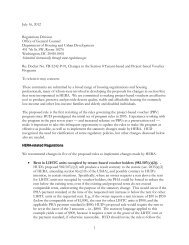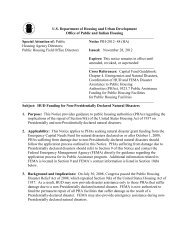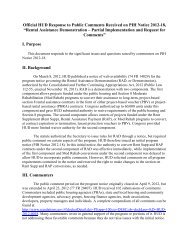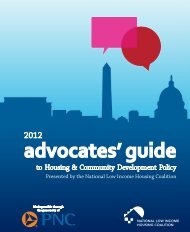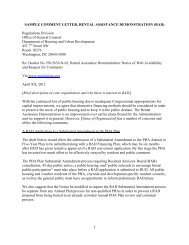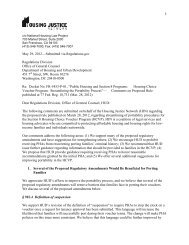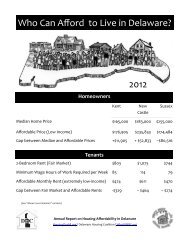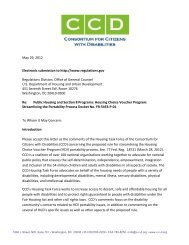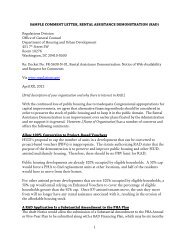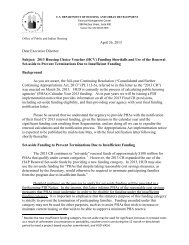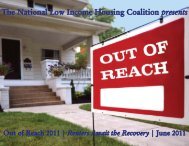Dark Before the Storm (.pdf, 131 KB) - National Low Income Housing ...
Dark Before the Storm (.pdf, 131 KB) - National Low Income Housing ...
Dark Before the Storm (.pdf, 131 KB) - National Low Income Housing ...
Create successful ePaper yourself
Turn your PDF publications into a flip-book with our unique Google optimized e-Paper software.
Increased Prevalence of <strong>Housing</strong> Problems Overall for <strong>Low</strong> <strong>Income</strong><br />
Renters<br />
A previous NLIHC report using <strong>the</strong> 1990 and 2000 Comprehensive <strong>Housing</strong> Affordability Strategy (CHAS) data (See<br />
Appendix 1 for more information on CHAS data) found that during <strong>the</strong> 1990s, a decade of strong economic growth, <strong>the</strong><br />
shares of all renter households with housing problems and severe rent burdens fell slightly in each of <strong>the</strong> three low income<br />
groups examined, 2 but this trend did not continue in <strong>the</strong> 2000s. Shares of low income renters with at least one housing<br />
problem - paying too much for <strong>the</strong>ir housing, living in crowded conditions, or lacking standard plumbing and kitchen<br />
facilities (See Box 1 for definitions of key terms) - were higher nationally and in nearly every state in 2005-2007 compared<br />
to <strong>the</strong> 2000 data (See Appendix 2, Table A-1). 3 This meant that even before <strong>the</strong> recession low income Americans had less to<br />
spend on non-housing necessities or were making unacceptable trade-offs to put a roof over <strong>the</strong>ir head.<br />
In <strong>the</strong> 1990s, housing problems became more concentrated among <strong>the</strong> lowest income renter households. In 2005-2007, 77%<br />
of ELI renters faced a housing problem, compared to 74% identified in <strong>the</strong> 2000 data (See Appendix 2, Table A-1). However,<br />
between <strong>the</strong> two surveys, <strong>the</strong>se problems moved up <strong>the</strong> income scale in that VLI renters saw <strong>the</strong> largest increase in <strong>the</strong> share<br />
of households with at least one housing problem. Looking at <strong>the</strong> percentage of households with housing problems in each<br />
Box 1: Definitions<br />
HUD <strong>Income</strong> Definitions Used for Renter Households<br />
Area Median <strong>Income</strong> (AMI) . . . . . . . . . . . . . . . . . . . . . . . . . . . . . . . . . . . . . . . . . . . . . . . . . . . . . .Local area median income<br />
Extremely <strong>Low</strong> <strong>Income</strong> (ELI). . . . . . . . . . . . . . . . . . . . . . . . . . . . . . . . . . . . . . . . . . . . . . . . . . . . . . . . . . . . . . . 0-30% of AMI<br />
Very <strong>Low</strong> <strong>Income</strong> (VLI) . . . . . . . . . . . . . . . . . . . . . . . . . . . . . . . . . . . . . . . . . . . . . . . . . . . . . . . . . . . . . . . . . . 31-50% of AMI<br />
<strong>Low</strong> <strong>Income</strong> (LI) . . . . . . . . . . . . . . . . . . . . . . . . . . . . . . . . . . . . . . . . . . . . . . . . . . . . . . . . . . . . . . . . . . . . . . . . 51-80% of AMI<br />
Not <strong>Low</strong> <strong>Income</strong> . . . . . . . . . . . . . . . . . . . . . . . . . . . . . . . . . . . . . . . . . . . . . . . . . . . . . . . . . . . . . . . Greater than 80% of AMI<br />
Definitions of Cost Burden<br />
Cost Burden: The percent of a household’s income spent on housing.<br />
Unaffordable Cost Burden: Spending over 30% of household income on housing.<br />
Severe Cost Burden: Spending over 50% of household income on housing.<br />
O<strong>the</strong>r Problems: In addition to unaffordable cost burden, <strong>the</strong> CHAS data identify overcrowding (more than one<br />
person per room) and substandard housing (lacking complete kitchen or plumbing facilities).<br />
2 Nelson, Kathryn P., Treskon, Mark. & Pelletiere, Danilo. (2004). Losing Ground in <strong>the</strong> Best of Times: <strong>Low</strong> <strong>Income</strong> Renters in <strong>the</strong> 1990s.<br />
Washington, DC: <strong>National</strong> <strong>Low</strong> <strong>Income</strong> <strong>Housing</strong> Coalition.<br />
3 This report examines national and state data, but it is also possible to observe within state differences by using CHAS county or city data. For<br />
an example, see: Mierzwa, E. & Nelson, K. with Newberger, H. (2010). Affordability and availability of rental housing in Pennsylvania. Philadelphia,<br />
PA: Federal Reserve of Philadelphia.<br />
3



